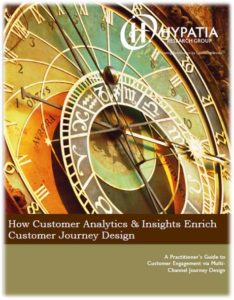Why do organizations seek to design effective multi-channel customer journeys? Customers demand it. Technology has enabled consumers to use multiple channels to interact at the time, place, and manner of their preference. In order to defend or retain market share and to potentially increase top line growth and cost reductions, businesses are compelled to respond to customer demands.
Leveraging multi-channel customer analytics and insights to enrich customer journey design has the potential to:
- Optimize omni-channel[2] customer interactions and engagement;
- Enhance employee engagement via “guided intelligenceTM “(e.g. a version of next best offer);
- Improve the customers’ purchase (commerce) experience;
- Segment, profile, predict and prescribe best practices for optimal types of customer engagement;
- Mitigate identity theft, fraud & risk, (See “Customer Identity Authentication: Best Practices in Avoiding Identity Theft, Fraud & Risk.”);
- Improve operational business processes through a customer-centric lens.
Customer Analytics and Insights
Insights gleaned from business intelligence reports and dashboards are worthwhile for decision support, early warning signals or identifying trends that warrant further investigation before taking action. However, advances in analytical technology (cognitive and machine learning) for example—combined with the proliferation of customer engagement channels has created the potential to fuel omni-channel customer journey design.
At present, there are five main types of advanced analytics:
- Descriptive-Identifies customer segments using metrics such as frequency, lifetime value, or behavior, in order to create propensity models.
- Diagnostic-Explores causal relationships like root cause analysis to better understand why customers purchase or pass on offers.
- Predictive-Uses customers’ past behavior with seasonal or lifestyle triggers to model and predict future behavior.
- Prescriptive-Optimizes knowledge from aforementioned three advanced analysis techniques via synthesis, and “what if?” or Monte Carlo simulations to suggest best outcomes in the form of guidance.
- Cognitive-Bridges the gap among machine learning (automated self-learning from experience and the ability to identify associations), the potential of Big Data and practical decision-making in real time with confidence scores that reflect the accuracy of responses.[3]
It should come as no surprise that enterprise-level omni-channel customer analytics, similar to Big Data Analytics (BDA), encompass numerous information sources, multiple technologies (software and hardware), nimble business processes and specialized human expertise in advanced analytics. Not surprisingly, this Hypatia Research Group study found that global organizations are successfully utilizing various analytical techniques in the form of these types of engagement. (See Figure 1)
Research Approach:
Hypathia Research Group surveyed more than 3000 global executives directly involved with extrapolating and applying customer insights with goals such as growth acceleration, service and support enhancement, customer acquisition and retention improvements.
Input from 566 respondents that actually use, recommend, influence, hold budget or veto power over the purchase of enterprise customer analytics and insights, customer engagement and journey design process software were included in our analysis of how, why or when organizations:
- Invest in customer analytics and journey design software solutions—and how much is budgeted through 2018?
- Measure productivity and effectiveness of customer analytics and journey design initiatives and how often?
- Prioritize specific customer analytics and journey design initiatives against software selection criteria?
- Commit a percentage of company revenues to customer analytics and journey design program investment?
- Realize a return on investment (ROI)?
- Evaluate and ultimately select specific customer analytics and journey design vendors or consulting firms?
Further analysis is available in our latest Galaxy study. All rights reserved. No part of this research study may be re-purposed, distributed, translated or published in any format without the express written consent of the Hypatia Research Group, LLC and its management. Permission to link to this research must be requested in writing. For advisory services or assistance with vendor selection, requirements gathering or business process mapping, contact [email protected]. For information on licensing, reprint or purchase of research, please contact [email protected]
[1] See “Delivering Big Data Analytics Insights: Why Choose Between Accuracy, Agility or Speed?”
[2] Omni-channel versus multi-channel: omni-channel is the use of all physical channels (offline) and digital channels (online) which offers a seamless, innovative and unified customer experience. Multi-channel is the use of three or more channels of engagement.
[3] In the consumer world, pieces of cognitive analytics form the core of artificial personal assistants such as Apple’s Siri® voice recognition software and the Google Now service, as well as the backbone for the Xbox® video game system’s verbal command interface in Kinect®.
